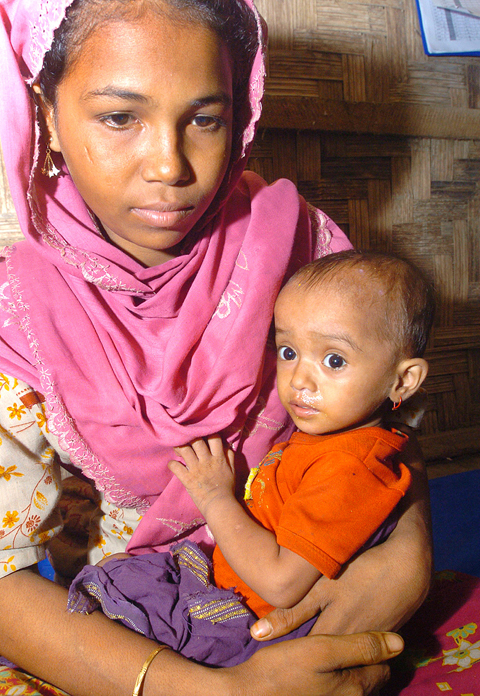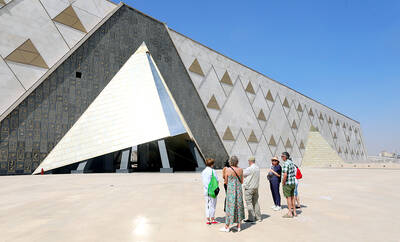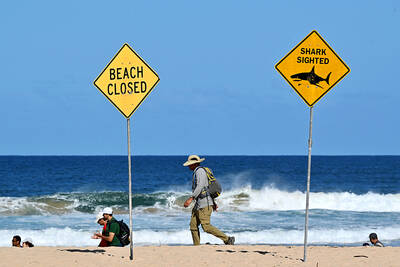Shansida Begum finally has a home with four relatively sturdy walls and a roof to keep out southern Bangladesh’s heavy monsoon rains.
The bamboo hut is nothing fancy, but it’s a world of comfort compared to the flimsy makeshift shelter she and her family have called home for the past 10 years.
One of about 12,000 Burmese Muslims living in an unofficial camp in southern Bangladesh, Shansida says she barely remembers life in the country of her birth.

PHOTO: AFP
Her family, ethnic Rohingyas, fled Rakhine State across the border in the country formerly known as Burma when she was 12 years old to escape persecution by the military junta, which is accused of severely restricting Muslims’ rights to travel and marry, and subjecting many to slave labor.
Now 22, Shansida says she still considers herself Burmese, but knows that unless the political situation changes in Myanmar, her 18-month-old daughter will only see her country from the Bangladeshi side of the Naf River, which divides the two nations.
“We’re Burmese but we live here. We have no food and water here but it’s still better than how we are treated in Burma,” she said.
In the early 1990s, more than 250,000 Rohingyas fled to Bangladesh. Since then, more than 230,000 have been repatriated, with almost 28,000 living in two official refugee camps in southern Bangladesh, where the UN provides medical care.
But the UN cannot help people like Shansida as the Bangladeshi government has not granted refugee status to any Rohingyas since 1992.
The world body estimates up to 300,000 Rohingas live in southern Bangladesh, many of them blending in with the local community.
Until the move to the new unofficial site which was funded by the European Commission Humanitarian Office (ECHO), the stateless Rohingyas who make up Shansida’s community lived along a narrow stretch of mud flats between a busy main road and the Naf.
That land was prone to flooding, and water-borne diseases were a part of life. Road accidents, some fatal, were frequent.
Pia Prytz Phiri, the UN High Commissioner for Refugees representative in Bangladesh, said ECHO’s willingness to fund the structures at the new site helped convince the government to allow the residents to move there.
Although technically not permitted to work in Bangladesh, many residents work as day laborers, undercutting locals by accepting low wages. Others collect and sell firewood, others simply beg, and about 150 women are believed to work as prostitutes.
The medical charity Medecins Sans Frontieres (MSF) has been working with the group since April 2006 to provide healthcare.
MSF project coordinator Salah Ibrahim Dongu’du said that while the new huts were a vast improvement on previous living conditions, he was not optimistic they would bring much change.
“It doesn’t mean the end of the problem. There will still be problems,” he said. “Most of the children are malnourished. They have no land to cultivate and legally they are not allowed to work so it makes it difficult for them.”
As one of the poorest countries in the world, Bangladesh insists the Rohingyas return to Myanmar and is reluctant to grant them refugee status.
UN High Commissioner for Refugees Antonio Guterres visited the camp in May and suggested “voluntary repatriation” to Myanmar was the best solution for the undocumented Rohingyas.
But Dongu’du is skeptical.
“They don’t want to go back to Burma even though they are not enjoying their living conditions in Bangladesh,” he said.
A Rohingya elder, Suriyaya Begam said returning to Myanmar would make life worse for her people.

With much pomp and circumstance, Cairo is today to inaugurate the long-awaited Grand Egyptian Museum (GEM), widely presented as the crowning jewel on authorities’ efforts to overhaul the country’s vital tourism industry. With a panoramic view of the Giza pyramids plateau, the museum houses thousands of artifacts spanning more than 5,000 years of Egyptian antiquity at a whopping cost of more than US$1 billion. More than two decades in the making, the ultra-modern museum anticipates 5 million visitors annually, with never-before-seen relics on display. In the run-up to the grand opening, Egyptian media and official statements have hailed the “historic moment,” describing the

SECRETIVE SECT: Tetsuya Yamagami was said to have held a grudge against the Unification Church for bankrupting his family after his mother donated about ¥100m The gunman accused of killing former Japanese prime minister Shinzo Abe yesterday pleaded guilty, three years after the assassination in broad daylight shocked the world. The slaying forced a reckoning in a nation with little experience of gun violence, and ignited scrutiny of alleged ties between prominent conservative lawmakers and a secretive sect, the Unification Church. “Everything is true,” Tetsuya Yamagami said at a court in the western city of Nara, admitting to murdering the nation’s longest-serving leader in July 2022. The 45-year-old was led into the room by four security officials. When the judge asked him to state his name, Yamagami, who

‘CHILD PORNOGRAPHY’: The doll on Shein’s Web site measure about 80cm in height, and it was holding a teddy bear in a photo published by a daily newspaper France’s anti-fraud unit on Saturday said it had reported Asian e-commerce giant Shein (希音) for selling what it described as “sex dolls with a childlike appearance.” The French Directorate General for Competition, Consumer Affairs and Fraud Control (DGCCRF) said in a statement that the “description and categorization” of the items on Shein’s Web site “make it difficult to doubt the child pornography nature of the content.” Shortly after the statement, Shein announced that the dolls in question had been withdrawn from its platform and that it had launched an internal inquiry. On its Web site, Le Parisien daily published a

DEADLY PREDATORS: In New South Wales, smart drumlines — anchored buoys with baited hooks — send an alert when a shark bites, allowing the sharks to be tagged High above Sydney’s beaches, drones seek one of the world’s deadliest predators, scanning for the flick of a tail, the swish of a fin or a shadow slipping through the swell. Australia’s oceans are teeming with sharks, with great whites topping the list of species that might fatally chomp a human. Undeterred, Australians flock to the sea in huge numbers — with a survey last year showing that nearly two-thirds of the population made a total of 650 million coastal visits in a single year. Many beach lovers accept the risks. When a shark killed surfer Mercury Psillakis off a northern Sydney beach last